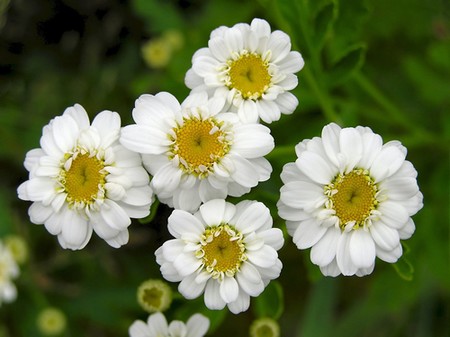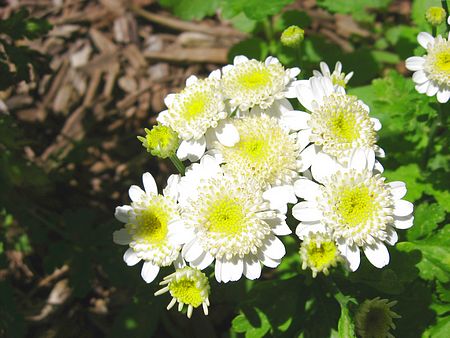Feverfew is a pretty member of the daisy family, Compositae. Though now in the genus Tanacetum, it was previously in another Compositae genus, Chrysanthemum, (the others are Matricaria and Pyrethrum). Matricaria was so called because of the plant’s beneficial relationship to the matrix, the Latin word for womb, and feverfew has been used for centuries for a wide range of women’s problems. The name pyrethrum comes for the Creek pyro meaning fire, as the roots of feverfew have a hot taste.
Culpeper said that feverfew is ruled by Venus and ‘hath commended it to succour our sisters to be a general strengthener of their wombs and to remedy such infirmities as a careless midwife hath there caused; if they will be pleased to make use of her herb boiled in white wine and drink the decoction, it cleanseth the womb, expels the afterbirth and doth a woman all the good she can desire of a herb’.
Feverfew has other names which indicate its usefulness for women. Parthenium comes from the Latin meaning virgin, and it was called mavdewecd as it was considered valuable for treating the kind of emotions and ‘hysterical distempers’ that young women were said to be prone to. The name bachelor’s buttons comes from the tradition of young men who wished to gain the love of a lady by carrying the flowers in their pockets. Feverfew also derives its name from its ability to bring down fevers.
Feverfew grows in any soil and seeds itself easily.
Herbal remedy
Feverfew was highly valued in the days of Culpeper and Gerard for relieving ague, or malaria, as well as colds and catarrh. It was frequently used for menstrual problems and other women’s complaints. It was also considered valuable for a variety of nervous problems including hysteria, and ir is interesting that this emotion was commonly ascribed to women and relates to the womb, (indicated by words such as hysterectomy for surgical removal of the womb). It was used specifically for highly nervous people who were oversensitive to pain, and prone to sudden fits of irritability or anger. It was prescribed for convulsions and for soothing fretful children.
More recently, feverfew has gained fame as an excellent remedy for headaches and migraine. Research and clinical trials have shown that intractable migraines in 70 per cent of sufferers improved when taking feverfew, while one in three-had no further attacks. The leaves can be eaten fresh every’ day between two pieces of bread as a sandwich (taken alone they may cause mouth ulcers in some sensitive people).
Feverfew has a bitter taste, and has a beneficial action on the liver and digestion, enhancing the appetite and digestion, allaying nausea and vomiting and helping to clear heat and toxins from the system. It will help relieve the pain and inflammation of arthritis and reduce symptoms associated with a sluggish liver. It acts as a tonic to the nervous system, relaxing tension and lifting depression and promoting sleep. It has also been used to relieve nerve pain, as in trigeminal neuralgia and sciatica.
Feverfew when taken in hot infusion will, as its name suggests, increase perspiration and reduce fevers. It will also act as a decongestant, clearing phlegm, chronic catarrh and sinusitis. It has also been used for asthma, and other allergies such as hay fever — research suggests that it inhibits release of substances which trigger allergies and migraines.
Externally, a tincture of the fresh plant can be dabbed on to insect stings and bites to relieve pain and swelling, and a dilute tincture used as a skin lotion is said to repel insects, as well as remove pimples, boils and haemorrhoids.
Homeopathic remedy: Pyrethrum Parthenium
Pyrethrum parthenium is prescribed for a range of nervous symptoms like those indicating the use of feverfew the herb, including convulsions, twitching, restlessness, and delirium.
The flower essence
The flower essence feverfew is taken for headaches and migraines, particularly those experienced in a cyclical pattern by women, according to their cycle of hormonal changes.

